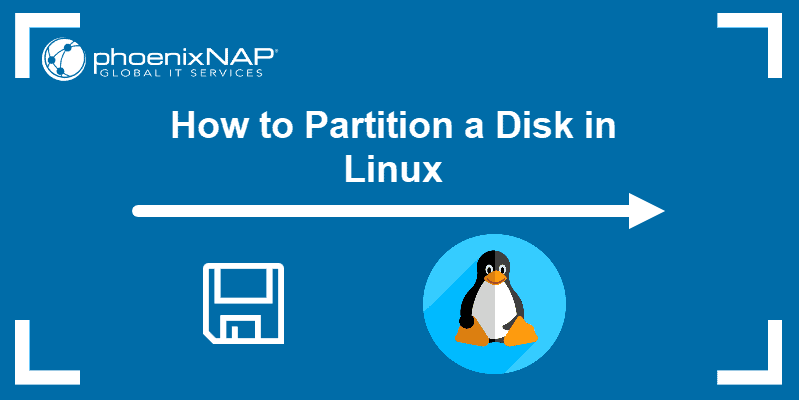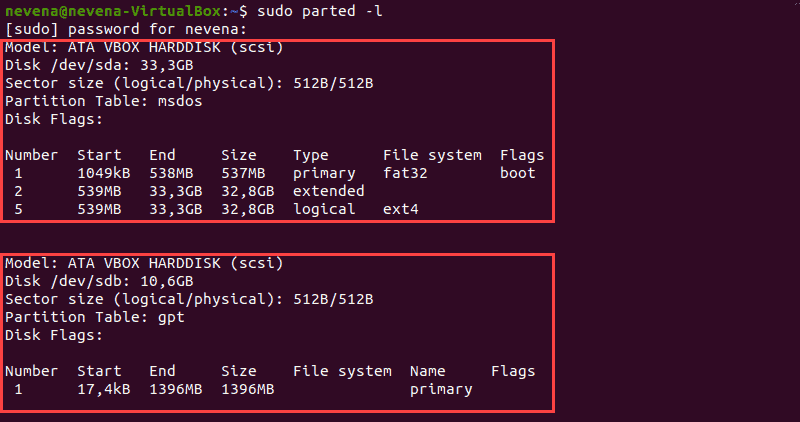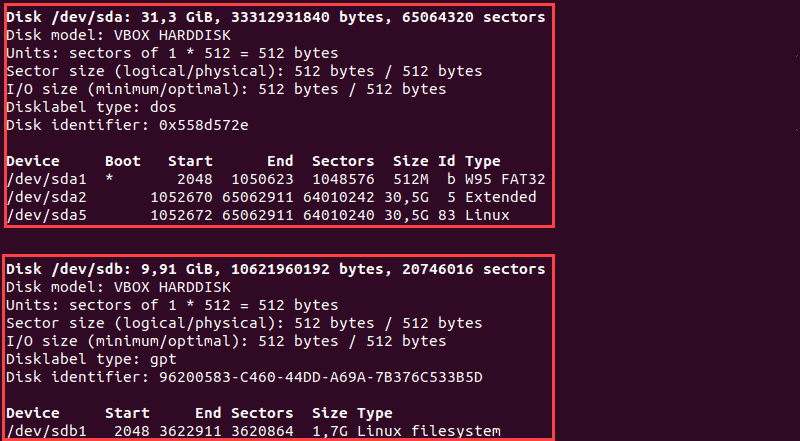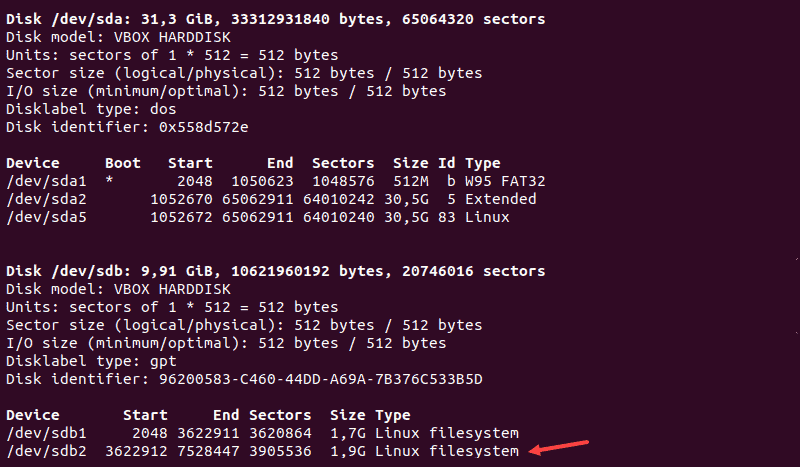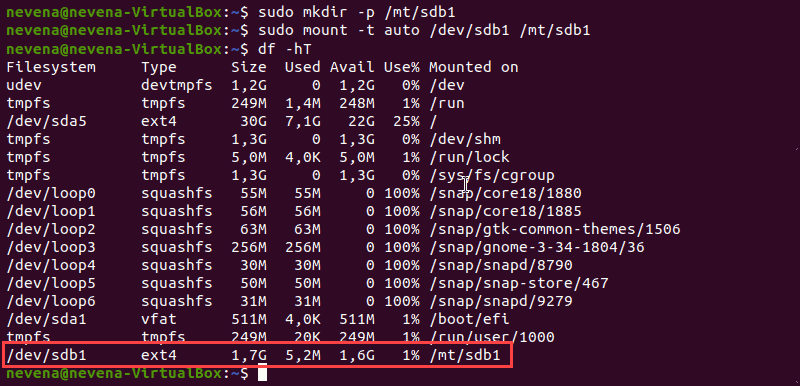- Partitioning basics
- Partitioning Conventions
- Primary Partition Rules and Conventions
- Extended Partitions
- Logical Partitions
- How to Create Partitions in Linux
- Option 1: Partition a Disk Using parted Command
- Step 1: List Partitions
- Step 2: Open Storage Disk
- Step 3: Make a Partition Table
- Step 4: Check Table
- Step 5: Create Partition
- Option 2: Partition a Disk Using fdisk Command
- Step 1: List Existing Partitions
- Step 2: Select Storage Disk
- Step 3: Create a New Partition
- Step 4: Write on Disk
- Format the Partition
- Mount the Partition
Partitioning basics
When you buy a new hard drive, it usually comes in an unformatted state. There are no partitions or file systems on it and it is ready for partitioning and formatting. It usually comes with a disk with a formatting tool on it which will create one or more partitions on this hard drive based on Microsoft’s FAT file system, but partition creation and formatting can be done with any partitioning tool, though there are certain issues when dealing with Windows on multi-boot systems, and with using Linux partition tools like GParted to modify Windows partitions). Upon launching GPartEd from the Ubuntu Live CD (selecting «System/Administration/Partition Editor» from the Launch Bar at top) and (if necessary) selecting the hard drive, the drive will look like this:
Notice that the entire drive is marked «Unallocated» and is called «Free Space.» The drive is ready to create partitions on. I will start with the types of partitions that can be created and their purposes. Drives which have already been partitioned and formatted will follow these conventions, so in order to successfully and efficiently repartition them requires knowledge of these conventions.
There are three types of partitions with which you will be dealing; Primary, Extended, and Logical partitions.
Partitioning Conventions
In «Partitioning Basics», I mentioned the «Unallocated Free Space» on a new drive. All partitions created in this Free Space are created under «Primary partition» rules and conventions.
Primary Partition Rules and Conventions
You can only create four Primary partitions on any single physical hard drive. This partition limit extends to the Linux Swap partition as well as for any Operating System installation or extra special purpose partitions, such as separate /root, /home, /boot, etc., that you might want to create.
If you attempt to create more than four Primary Partitions, you will see the following warning:
Notice that when I tried to create a fifth partition, GPartEd gave me a message warning that this could not be accomplished. How do we circumvent this limitation and create more partitions? With an Extended Partition.
Extended Partitions
While in most circumstances, such as a «Guided Install» from the Live CD on a new Windows computer, four partitions are enough, there are circumstances in which you might need to create more than four partitions. This is the reason for an Extended partition.
- When you create an Extended partition, it occupies one of the four Primary partition spots. When an Extended partition exists on a hard drive, only three Primary partitions may co-exist with it. (See Primary Partitions Rules and Conventions) If there are four Primary partitions already on a hard drive and you wish to create an Extended partition in which to create more, one of the Primary partitions must be deleted in order to create it.
- Only one extended partition may be created on a hard drive (though you can have one extended partition on each of the hard drives connected to your system). The partition editor will not allow it, and it would serve no purpose at any rate. If you need the extra Extended partition space, you only need expand the one you have.
- An Extended partition cannot be formatted with a filesystem, such as ext4, FAT, or NTFS, nor can it directly hold data. That is the function of the Logical Drives which are created within it.
Logical Partitions
A partition created within an Extended partition is called a Logical partition. Any number of Logical partitions may be created within an Extended partition, and they may be formatted with any filesystem.
All Operating Systems that I am aware of are able to access any Logical partition that is formatted to a compatible filesystem. For instance, while Windows will not recognize a Linux ext2 partition without a third-party driver, it will be able to access any partition formatted with FAT or NTFS, depending on the version of Windows. Linux, of course, will access all of these.
HowtoPartition/PartitioningBasics (последним исправлял пользователь cpe-172-116-79-89 2018-01-15 10:28:37)
The material on this wiki is available under a free license, see Copyright / License for details
You can contribute to this wiki, see Wiki Guide for details
How to Create Partitions in Linux
Creating disk partitions enables you to split your hard drive into multiple sections that act independently.
In Linux, users must structure storage devices (USB and hard drives) before using them. Partitioning is also useful when you are installing multiple operating systems on a single machine.
In this step-by-step tutorial, you will learn how to create a partition using the Linux parted or fdisk command.
- A system running Linux
- A user account with sudo or root privileges
- Access to a terminal window / command line (Activities >Search >Terminal)
Option 1: Partition a Disk Using parted Command
Follow the steps below to partition a disk in Linux by using the parted command.
Step 1: List Partitions
Before making a partition, list available storage devices and partitions. This action helps identify the storage device you want to partition.
Run the following command with sudo to list storage devices and partitions:
The terminal prints out available storage devices with information about:
- Model – Model of the storage device.
- Disk – Name and size of the disk.
- Sectorsize – Logical and physical size of the memory. Not to be confused with available disk space.
- PartitionTable – Partition table type (msdos, gpt, aix, amiga, bsd, dvh, mac, pc98, sun, and loop).
- DiskFlags – Partitions with information on size, type, file system, and flags.
- Primary – Holds the operating system files. Only four primary partitions can be created.
- Extended – Special type of partition in which more than the four primary partitions can be created.
- Logical – Partition that has been created inside of an extended partition.
In our example, there are two storage devices ( /dev/sda and /dev/sdb ):
Note: The first storage disk ( dev/sda or dev/vda ) contains the operating system. Creating a partition on this disk can make your system unbootable. Only create partitions on secondary disks ( dev/sdb , dev/sdc , dev/vdb , or dev/vdc ).
Step 2: Open Storage Disk
Open the storage disk that you intend to partition by running the following command:
Always specify the storage device. If you don’t specify a disk name, the disk is randomly selected. To change the disk to dev/sdb run:
The dev/sdb disk is open:
Step 3: Make a Partition Table
Create a partition table before partitioning the disk. A partition table is located at the start of a hard drive and it stores data about the size and location of each partition.
Partition table types are: aix, amiga, bsd, dvh, gpt, mac, ms-dos, pc98, sun, and loop.
The create a partition table, enter the following:
mklabel [partition_table_type]For example, to create a gpt partition table, run the following command:
Type Yes to execute:
Note: The two most commonly used partition table types are gpt and msdos. The latter supports up to sixteen partitions and formats up to 16TB of space while gpt formats up to 9.4ZB and supports up to 128 partitions.
Step 4: Check Table
Run the print command to review the partition table. The output displays information about the storage device:
Note: Run help mkpart command to get additional help on how to create a new partition.
Step 5: Create Partition
Let’s make a new 1854MB-partition using the ext4 file system. The assigned disk start shall be 1MB and the disk end is at 1855MB.
To create a new partition, enter the following:
mkpart primary ext4 1MB 1855MBAfter that, run the print command to review information on the newly created partition. The information is displayed under the Disk Flags section:
In a gpt partition table, the partition type is the mandatory partition name. In our example, primary is the name of the partition, not the partition type.
To save your actions and quit, enter the quit command. Changes are saved automatically with this command.
Note: The “You may need to update /etc/fstab file” message signals that the partition can be mounted automatically at boot time.
Option 2: Partition a Disk Using fdisk Command
Follow the steps below to partition a disk in Linux by using the fdisk command.
Step 1: List Existing Partitions
Run the following command to list all existing partitions:
The output contains information about storage disks and partitions:
Step 2: Select Storage Disk
Select the storage disk you want to create partitions on by running the following command:
The /dev/sdb storage disk is open:
Step 3: Create a New Partition
1. Run the n command to create a new partition.
2. Select the partition number by typing the default number (2).
3. After that, you are asked for the starting and ending sector of your hard drive. It is best to type the default number in this section (3622912).
4. The last prompt is related to the size of the partition. You can choose to have several sectors or to set the size in megabytes or gigabytes. Type +2GB to set the size of the partition to 2GB.
A message appears confirming that the partition is created.
Step 4: Write on Disk
The system created the partition, but the changes are not written on the disk.
1. To write the changes on disk, run the w command:
2. Verify that the partition is created by running the following command:
As you can see, the partition /dev/sdb2 has been created.
Format the Partition
Once a partition has been created with the parted of fdisk command, format it before using it.
Format the partition by running the following command:
Note: Check out our guide and learn how to format and mount disk partitions in Linux using ext4, FAT32, or NTFS file system!
Mount the Partition
To begin interacting with the disk, create a mount point and mount the partition to it.
1. Create a mount point by running the following command:
2. After that, mount the partition by entering:
sudo mount -t auto /dev/sbd1 /mt/sdb1The terminal does not print out an output if the commands are executed successfully.
3. Verify if partition is mounted by using the df hT command:
Note: If you have NTFS partitions on your hard drive, check out our article on how to mount NTFS partitions in Linux.
After following this step-by-step tutorial, you should have a better understanding on how to partition a disk in Linux by using the parted or fdisk command.
For more Linux commands, see our Linux Commands Cheat Sheet.
Dejan is the Head of Content at phoenixNAP with over 8 years of experience in Web publishing and technical writing. Prior to joining PNAP, he was Chief Editor of several websites striving to advocate for emerging technologies. He is dedicated to simplifying complex notions and providing meaningful insight into data center and cloud technology.
sudo stands for SuperUser DO, and it’s used to temporarily elevate privileges in Linux. This guide will show.
Setting file and directory permission properly is important in multi-user systems such as Linux. You can set.
This article helps you install Ubuntu 20.04 on your machine. The latest Ubuntu Focal Fossa was released on.
Since there is no way to upgrade from CentOS 7 to CentOS 8, users need to go through the entire installation.


